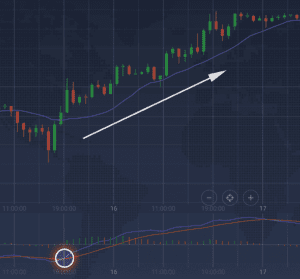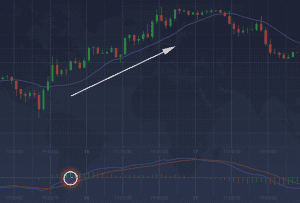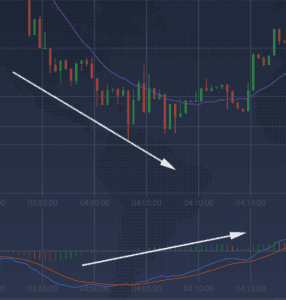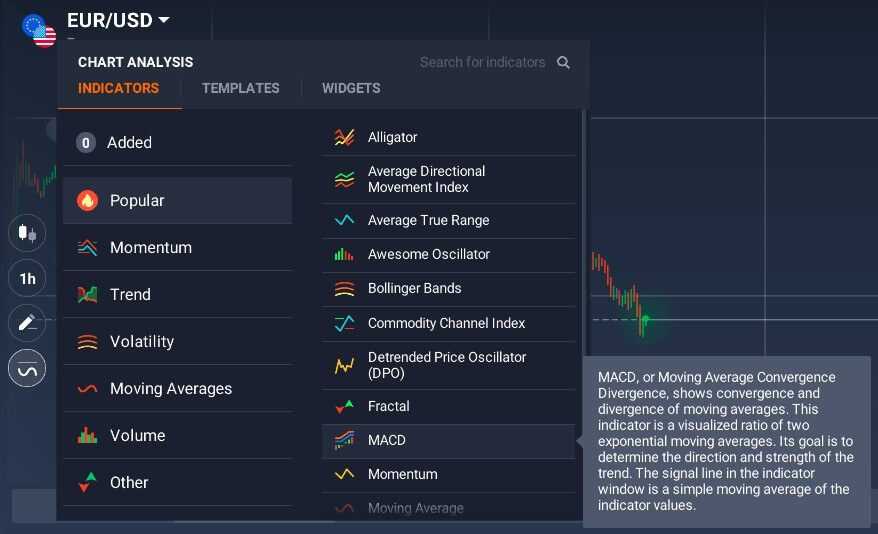As you probably already know, there is no single ‘best’ technical analysis indicator. Each of them has its time and place. However, if asked to choose their favorite tool, a lot of traders would answer “
MACD”.
Moving
Average
Convergence
Divergence is a trend-following indicator that is used to spot an emerging trend, whether upward or downward. It is by right one of the most effective and commonly used technical analysis tools ever created. In todays’ article, we will take a closer look at the indicator and learn how to apply it in trading.
What is MACD?
Moving Average Convergence Divergence will help you spot emerging trends, arguably the most important thing in any trading pursuit. But just as any other indicator, MACD has to be used correctly in order to yield tangible results. And you have to understand, what exactly you are working with.
Put simply,
MACD is a combination of two lines: a slower moving average (orange) and a faster moving average (blue). The difference between the two is displayed by the red and green bars — hence, the words ‘divergence’ and ‘convergence’ in the indicator’s name. By default, the faster moving average is calculated based on 12 periods, while the slower moving average uses 26 of them.
How to use it in trading?
MACD is a complex tool that can be used in several ways:

First, you may want to look for two moving averages crossing over each other.
When the faster moving average rises above a slower moving average, some would say that an uptrend is expected. Conversely, when a faster moving average drops below the slower moving average, a downward trend is quite possible. This is the most common way to use MACD in trading.

Second, keep an eye on the so-called centerline crossover.
When the faster moving average moves above the central line (white), it is possible that the trend will go up. And vice versa, when the faster moving average moves below the baseline, it is possible that the price will depreciate. Probably not the most common way to use MACD, it can still be effective.

Finally, watch for a thing called
divergence. When the price action and the MACD chart demonstrate opposite movement, the trend may soon reverse.
A bullish divergence forms when a security forms a lower low and the MACD forms a higher low. A bearish divergence forms when a security forms a higher high and the MACD Line forms a lower high. This is an advanced technique and will probably require some training to be applied correctly. Still, it definitely deserves your attention.
Note that all indicators, no matter how good, can and will provide false signals from time to time. It is, therefore, advised to double check the signals you receive with other indicators or different timeframes (preferably both).
How to set up?
Setting up MACD is easy. Simply do the following:
1. Click on the ‘Indicators’ button in the bottom left corner of the screen,
2. Go to the ‘Popular’ tab,

3. Choose MACD from the list of available indicators,
4. Without changing the setting, click ‘Apply’.
And you are good to go. Now, when you know how to set up and trade using this indicator, give MACD a try and consider adding it to your trading system.
 First, you may want to look for two moving averages crossing over each other. When the faster moving average rises above a slower moving average, some would say that an uptrend is expected. Conversely, when a faster moving average drops below the slower moving average, a downward trend is quite possible. This is the most common way to use MACD in trading.
First, you may want to look for two moving averages crossing over each other. When the faster moving average rises above a slower moving average, some would say that an uptrend is expected. Conversely, when a faster moving average drops below the slower moving average, a downward trend is quite possible. This is the most common way to use MACD in trading.
 Second, keep an eye on the so-called centerline crossover. When the faster moving average moves above the central line (white), it is possible that the trend will go up. And vice versa, when the faster moving average moves below the baseline, it is possible that the price will depreciate. Probably not the most common way to use MACD, it can still be effective.
Second, keep an eye on the so-called centerline crossover. When the faster moving average moves above the central line (white), it is possible that the trend will go up. And vice versa, when the faster moving average moves below the baseline, it is possible that the price will depreciate. Probably not the most common way to use MACD, it can still be effective.
 Finally, watch for a thing called divergence. When the price action and the MACD chart demonstrate opposite movement, the trend may soon reverse. A bullish divergence forms when a security forms a lower low and the MACD forms a higher low. A bearish divergence forms when a security forms a higher high and the MACD Line forms a lower high. This is an advanced technique and will probably require some training to be applied correctly. Still, it definitely deserves your attention.
Note that all indicators, no matter how good, can and will provide false signals from time to time. It is, therefore, advised to double check the signals you receive with other indicators or different timeframes (preferably both).
Finally, watch for a thing called divergence. When the price action and the MACD chart demonstrate opposite movement, the trend may soon reverse. A bullish divergence forms when a security forms a lower low and the MACD forms a higher low. A bearish divergence forms when a security forms a higher high and the MACD Line forms a lower high. This is an advanced technique and will probably require some training to be applied correctly. Still, it definitely deserves your attention.
Note that all indicators, no matter how good, can and will provide false signals from time to time. It is, therefore, advised to double check the signals you receive with other indicators or different timeframes (preferably both).
 3. Choose MACD from the list of available indicators,
4. Without changing the setting, click ‘Apply’.
And you are good to go. Now, when you know how to set up and trade using this indicator, give MACD a try and consider adding it to your trading system.
3. Choose MACD from the list of available indicators,
4. Without changing the setting, click ‘Apply’.
And you are good to go. Now, when you know how to set up and trade using this indicator, give MACD a try and consider adding it to your trading system.

